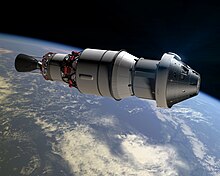Exploration Flight Test 1
| Mission emblem | |||
|---|---|---|---|

|
|||
| Mission dates | |||
| Mission: | Exploration Flight Test 1 | ||
| Dimensions: | 21000 kg | ||
| Launcher: | Delta IV Heavy | ||
| Crew: | unmanned | ||
| Begin: | December 5, 2014, 12:05 UTC | ||
| Starting place: | Cape Canaveral , LC-37B | ||
| Landing: | December 5, 2014, 16:29 UTC | ||
| Landing place: | Pacific Ocean off California | ||
| Flight duration: | 4 h 24 min | ||
| Earth orbits: | 2 | ||
| Recovery ship: | USS Anchorage | ||
| Orbit inclination : | 28.6 ° | ||
| Apogee : | 5800 km | ||
| ◄ Before / After ► | |||
|
|||
EFT-1 ( Exploration Flight Test 1 , Engl. For "research flight test 1") is the mission designation for the US Orion MPCV (Engl. Multi-Purpose Crew Vehicle ) of the NASA which was launched on December 5, 2014. It was the spaceship's first test flight, with which key systems were tested. Since the MPCV's actual launch vehicle, the SLS , was not yet completed at the time of the test flight, it was launched on a Delta IV Heavy from the United Launch Alliance .
Mission preparation
The Launch Abort System was completed in December 2013, which was inactive for this mission and could only disconnect from the crew module. In January 2014 the service module for the mission was completed, which was also not fully equipped.
At the beginning of 2014 two of the three components of the Orion MPCV were ready for EFT-1. In March 2014, a postponement of the launch date from September to December 2014 was announced; although the construction of the space capsule and the launcher were on schedule for a launch in the fall, priority was given to the United States Air Force with the launch of two spy satellites. On September 11, 2014, the now complete Orion MPCV was driven out of the Operations and Checkout Building and brought to the Payload Hazardous Servicing Facility to prepare for launch. On October 1, 2014, the Delta IV Heavy rocket was brought to the launch site and erected.
Mission history
The first attempts at launch on December 4, 2014 were canceled due to excessive wind speeds and two defective valves on the tanks. The spacecraft was launched on December 5, 2014 by a Delta IV Heavy from Launch Complex 37 of Cape Canaveral Air Force Station to complete a flight of several hours with two orbits of the earth. The upper stage of Delta IV was connected to the MPCV for energy supply until it re-entered the earth's atmosphere, as the photovoltaic panels were not installed. On the second orbit around the world, the spacecraft was brought to an increased altitude of about 5,800 km, which is about 15 times higher than the orbit of the ISS . Then it re-entered the earth's atmosphere at a speed of about 20,000 mph and watered down in the Pacific Ocean. During the entire flight, the spacecraft was under pressure, as it would have been with astronauts on board.
Mission objectives
Exploration Flight Test 1 was primarily intended to test important systems such as the on-board electronics, the heat shield and the parachutes. For this reason, the mission was also a preparation for Artemis 1 , the first launch of the MPCV with its SLS launcher in 2021.
Web links
- NASA: MPCV (English)
- NASA: SLS (English)
- NASA: Orion Flight Test. Exploration Flight Test-1. Press Kit December 2014 (English)
- NASA: Orion First Flight Test (English)
Individual evidence
- ↑ Ken Kremer: NASA Pressing Towards Fall 2014 Orion Test Flight - Service Module Complete. Universe Today, January 22, 2014, accessed February 2, 2014 .
- ^ Roland Rischer: Orion flight test postponed to December 2014. Raumfahrer.net, March 15, 2014, accessed March 16, 2014 .
- ^ Charles Black: NASA's next generation spacecraft Orion on track for 2014 test flight. SEN, March 3, 2013, accessed March 4, 2013 .
- ↑ Lockheed Martin Provides Details On Orion Spacecraft Plans For 2014. DefenseDaily, January 10, 2014, accessed January 19, 2014 .



